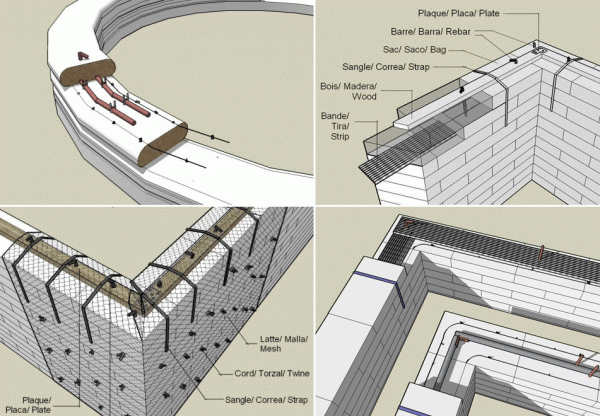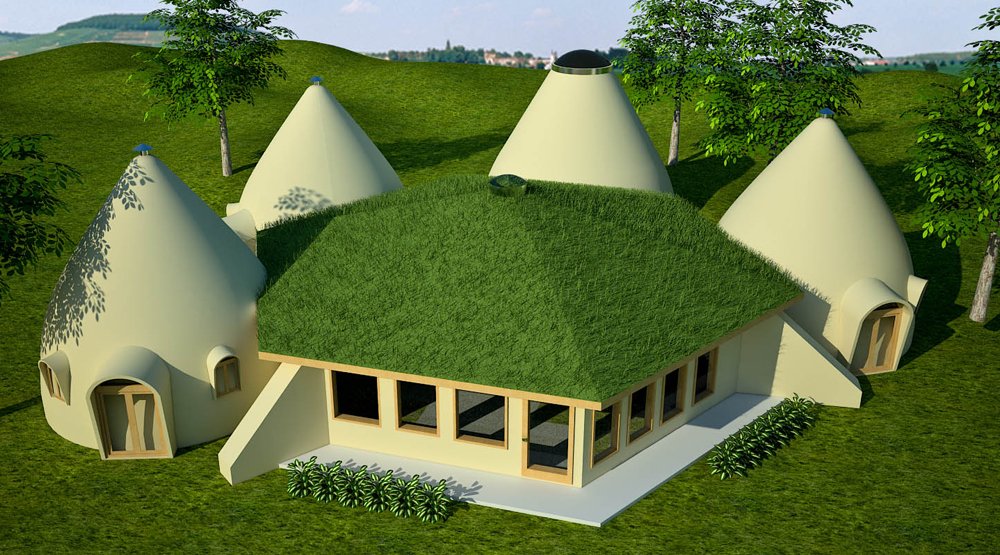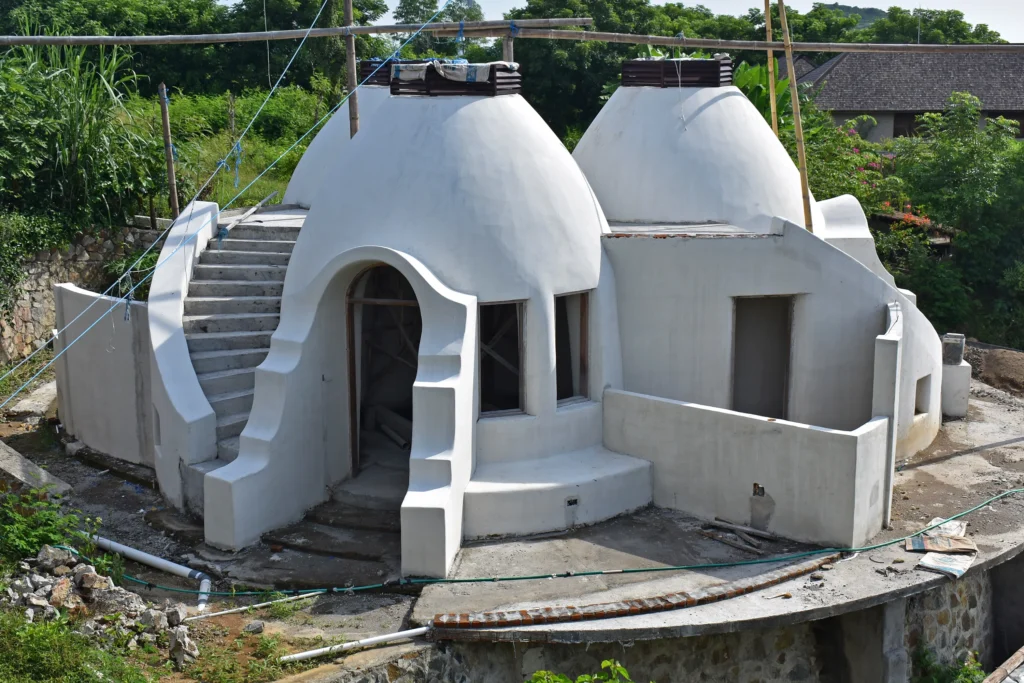From the rural villages of India to the slums of Africa, millions of people around the world in developing countries live in poverty with insufficient housing. In order to address this, there has been a recent spike in the use of Earth Bag homes. Earth Bag homes are dense walls constructed from filled sandbags and barbed wire, initially designed for disaster relief. With their immense strength, minimal building materials, and low cost, Earth Bag homes represent a potentially revolutionary solution to crumbling infrastructure and inadequate housing in parts of the world lacking proper access to building materials.
In this article, we discuss how Earth Bag homes are revolutionizing housing around the world and providing an affordable housing solution to those living in poverty. We’ll explain how durable these homes are and how they can be accessed by communities without access to traditional building materials.

Table Of Content.
- Introduction
- What are Earth Bag Homes?
- Technical Aspects of Earth Bag Homes
- Foundation of Earth Bag Homes
- Construction of Earth Bag Homes
- Building Codes for Earth Bag Homes
- Financing Earth Bag Homes
- Challenges and Solutions for Scaling Up Earth Bag Home Projects
- Future Prospects for Earth Bag Homes
- Conclusion
1. Introduction
Introduction:
The United Nations predicts that by 2050, 66% of the world’s population will reside in cities, and most population growth will occur in developing countries. Unfortunately, adequate housing remains a challenge in many regions of the world. Earthbag homes, an innovative and sustainable building technique, offer an alternative solution to traditional housing that can revolutionize the construction industry.
What Are Earthbag Homes?
Earthbag homes, also known as sandbag homes, are constructed from sacks filled with materials like soil, sand, and gravel, which are then stacked and compacted to form durable and safe walls. One of the highlights of earthbag homes is their affordability. They cost very little to build, mostly because the materials used are readily available locally. Moreover, they are energy-efficient and provide excellent insulation against both cold and hot climates.
Why Earthbag Homes Are Beneficial:
Earthbag homes can be constructed easily and quickly, and they’re perfect for locations that lack access to electricity, running water, or even skilled labor. They are also incredibly resistant to natural disasters like earthquakes, hurricanes, and high winds. Additionally, earthbag homes have a tiny carbon footprint and provide an eco-friendly way of living.
Moreover, earthbag homes can be designed to suit individual’s specific needs and preferences, ranging from single-room structures to multi-story dwellings. These structures can be built in the countryside as well as in urban settings, providing ample housing opportunities to developing nations.
💡 Key Takeaway: Earthbag homes offer a unique and innovative solution for affordable and durable housing in third-world countries. They are versatile, energy-efficient, and eco-friendly, and they can be constructed easily and quickly, even in challenging conditions.

2. What are Earth Bag Homes?
Earth Bag Homes is a sustainable and affordable housing solution that can revolutionize the way we address housing needs in third-world countries. These homes are made from strong, durable, and lightweight materials and are earthquake-resistant, making them an ideal solution for areas that are prone to natural disasters.
How are Earth Bag Homes built?
These homes are built using polypropylene bags filled with local, natural materials such as soil, sand, and gravel. The walls are then reinforced with barbed wire or wooden poles, creating a strong and sturdy structure.
Earth Bag Homes are highly affordable, with construction costs being as low as $3000
They are eco-friendly, using local and natural materials that reduce the carbon footprint associated with traditional construction
They are earthquake-resistant, making them a safe option for areas that experience natural disasters
These homes can be customized to meet the specific needs of the community and can be designed to suit different aesthetic preferences.
Quote:
According to Dr. Owen Geiger of the Natural Building Blog, “Earth Bag Homes are highly sustainable and offer a permanent and safe solution for addressing housing needs in developing countries. With proper training and support, anyone can learn to build these eco-friendly homes.”
💡 Key Takeaway: Earth Bag Homes are a highly affordable, eco-friendly, and sustainable housing solution that can help address the housing needs of developing countries. They are highly versatile and customizable, and when built correctly, can withstand natural disasters such as earthquakes, making them an ideal option for areas prone to natural disasters.
3. Technical Aspects of Earth Bag Homes
3. Technical Aspects of Earth Bag Homes
When it comes to the technical aspects of building an Earth Bag Home, several factors come into play. It’s important to use the right materials to ensure the home is structurally sound and can withstand earthquakes, floods, and other natural disasters. In addition, proper drainage, ventilation, and insulation must be considered to create a comfortable, livable space.
Materials: The Right Ingredients for a Solid Home
Structural Integrity: Building for Natural Disasters
Climate Control: Ventilate and Insulate for Comfort
One of the key features of Earth Bag Homes is their use of natural, locally-sourced materials like sand, gravel, clay, and straw. These materials are inexpensive, readily available, and sustainable. By using earthbags made of polypropylene or burlap sacks filled with these materials, highly durable structures can be built that are resistant to fire, pests, and weather extremes.
Structural Integrity: Building for Natural Disasters
In third-world countries where natural disasters are prevalent, building an Earth Bag Home can be a lifesaving decision. The domed or arched shape of the earthbag walls provides inherent structural stability, making them highly resistant to earthquakes, floods, and high winds. The use of barbed wire or rebar and plaster gives additional strength to the walls, preventing collapse or breach under stress.
Climate Control: Ventilate and Insulate for Comfort
Earth Bag Homes are naturally cool in hot climates and warm in cold climates, but proper ventilation and insulation can make them even more comfortable. Roof ventilation and well-placed windows can keep fresh air circulating, while insulating the walls with natural materials like straw bale or recycled materials like foam can keep the home warm in the winter and cool in the summer.
💡 Key Takeaway: When building an Earth Bag Home
4. Foundation of Earth Bag Homes
The foundation of earthbag homes is one of the key components that makes them a viable option for sustainable housing in third-world countries. Unlike traditional foundations, earthbag homes use a simple and cost-effective approach that can be constructed by anyone. First, a trench is dug and filled with a layer of gravel, followed by a layer of compacted earth. Then, bags filled with earth or other suitable materials are stacked on top of one another and compacted to form a strong and stable base. This method not only saves on costs, but it also reduces the environmental impact of traditional concrete foundations. As eco-architect Nader Khalili once said, “Today’s Earth is yesterday’s clay. The same Earth can become much more useful tomorrow if we understand how to process it and use it properly.” By using simple yet effective techniques like earthbag construction, we can revolutionize the way we build homes in third-world countries, providing affordable and sustainable solutions to those most in need.
💡 Key Takeaway: The foundation of earthbag homes is a simple and cost-effective approach that can revolutionize sustainable housing in third-world countries.
5. Construction of Earth Bag Homes
5. Construction of Earth Bag Homes
Earthbag homes are an innovative and sustainable solution to the housing crisis, especially in third-world countries. The process of building an earthbag home is simple and cost-effective, making it an ideal option for those with limited resources. Let’s take a closer look at the construction process of earthbag homes:
Materials
The basic materials required for an earthbag home are locally-sourced soil, sand, water, and bags made of either burlap or polypropylene. These materials are readily available, making it easy for communities to gather them.
Foundation
One of the most notable features of earthbag homes is their foundation. Unlike traditional homes that require a concrete foundation, earthbag homes use a simple gravel-filled trench for stability, reducing material cost and carbon footprint.
Wall Construction
The walls of an earthbag home are created by filling the bags with locally sourced soil and lining them up in rows. Each row is compacted to remove any air pockets and moistened to allow the soil to settle.
Quote: “The walls are sturdy and durable, able to withstand earthquakes and other natural disasters,” says Mark Lakeman, a sustainable housing expert.
Finishing Touches
After the walls are built, a finish can be added to the exterior, such as stucco, plaster or paint. A metal roof is added to complete the structure, protecting it from the elements.
💡 Key Takeaway: The construction of earthbag homes is a simple, cost-effective, and sustainable solution to the housing crisis in third-world countries. By using locally-sourced materials, such as soil and sand, the construction process significantly reduces the carbon footprint. Their sturdy and durable nature makes them capable of withstanding natural disasters, and with proper maintenance, they can last for decades.

6. Building Codes for Earth Bag Homes
Building codes are a critical aspect of constructing Earth Bag Homes in Third World countries. Without proper regulation and oversight, the structural integrity of these types of homes could be compromised, leading to devastating consequences in the event of a natural disaster. It’s crucial that local authorities establish building codes for Earth Bag Homes that are both safe and efficient. These codes should take into account the unique characteristics of the local environment, including soil types, rainfall patterns, and seismic activity. They should also include guidelines for proper drainage, ventilation, and insulation, to ensure that the homes are comfortable and livable. One approach to building codes for Earth Bag Homes is the “Pakistani Earthquake-resistant Building Code”. This code outlines specific requirements for foundation depth and width, wall thickness and reinforcement, and roof designs. By adhering to such codes and regulations, we can ensure that Earth Bag Homes will provide safe and reliable housing solutions for people in Third World countries.
: Benefits of Building Codes for Earth Bag Homes
Establishing building codes for Earth Bag Homes can yield many benefits. One of the primary advantages is safety. Proper codes will ensure that Earth Bag Homes are built to withstand natural disasters, such as earthquakes, hurricanes, and floods. This enhanced safety will give residents peace of mind and increase the likelihood that they will stay in their homes over the long term. Additionally, building codes can ensure that homes are constructed efficiently, minimizing waste and maximizing the use of local resources.
: The Role of the Local Community in Developing Building Codes
The process of developing building codes for Earth Bag Homes should involve the local community. This will help to ensure that the codes are tailored to the specific needs and resources of the community. It’s essential to engage local experts, such as architects, engineers, and builders, in the development process to ensure that the codes are practical and effective. By working collaboratively with the local community, we can develop codes that are widely accepted and adhered to, ensuring the long-term success of Earth Bag Homes as a viable housing option in Third World countries.
💡 Key Takeaway: Building codes are crucial for the construction of Earth Bag Homes in Third World countries. They ensure safety, efficiency, and livability and should be developed collaboratively with the local community to ensure their practicality and effectiveness.
7. Financing Earth Bag Homes
Sustainable housing is the need of the hour, and Earth Bag homes are an excellent option for third-world countries with a dire need for affordable and eco-friendly homes. Financing such homes can be a challenge, but with the right approach, it is possible. Here are some ways to finance Earth Bag homes:
1. Crowdfunding: Crowdfunding is an excellent way to raise funds for Earth Bag homes. Through crowdfunding, people can donate money towards building sustainable housing for those in need.
2. Government grants: Governments in developing countries provide grants for building affordable and sustainable homes. Earth Bag homes are an excellent alternative that can be promoted by the government.
3. Microfinance institutions: Microfinance institutions provide loans to small businesses and individuals for various purposes, and building sustainable homes can be one of them.
4. Collaborations with NGOs: Non-governmental organizations (NGOs) working towards promoting sustainable living can collaborate with the community to build Earth Bag homes.
5. Community participation: Communities can come together to build Earth Bag homes, and the costs can be shared among them.
As the cost of traditional housing continues to rise, Earth Bag homes can provide a sustainable and economical solution. Financing can be a challenge, but with the right approach, it is possible to build these eco-friendly homes for those in need.
💡 Key Takeaway: Financing Earth Bag homes can be done through crowdfunding, government grants, microfinance institutions, collaborations with NGOs, and community participation, providing an affordable and sustainable housing solution for those in need.

8. Challenges and Solutions for Scaling Up Earth Bag Home Projects
Challenges and Solutions for Scaling Up Earth Bag Home Projects:
While Earth Bag homes have the potential to revolutionize housing in third-world countries, scaling up projects can present several challenges. To ensure the success of the project, it is essential to address these challenges and come up with viable solutions. Here are some of the common challenges and possible solutions to overcome them:
1. Lack of Funding: One of the most significant challenges with scaling up Earth Bag home projects is a lack of funding. It can be difficult to secure financing for projects in remote or developing areas. However, there are several solutions to this problem. Earth Bag home projects can benefit from funding from non-profit organizations or crowdfunding campaigns.
2. Skill Training: The success of Earth Bag home projects relies heavily on the skill level of the workers involved. To build sustainable homes, workers must be trained in proper building techniques. Building schools to train workers is essential for scaling up Earth Bag home projects.
3. Lack of Infrastructure: In many third-world countries, there is a lack of basic infrastructure such as roads, water, and electricity. Developing infrastructure for the project area is vital. Governments could provide support in terms of transport infrastructure such as roads, and transportation of materials and equipment.
4. Building Codes: Earth Bag home construction may not be recognized by local building codes, creating hurdles for the project. To overcome this, building codes must be updated to include sustainable building methods.
5. Volunteer Burnout: Volunteer burnout is another challenge when scaling up Earth Bag home projects. It is essential to have a strong, dedicated team to ensure the success of the project.
💡 Key Takeaway: Scaling up Earth Bag home projects in third-world countries requires overcoming several challenges. These challenges include a lack of funding, skill training, infrastructure gaps, building codes, and volunteer burnout. The solutions to these are securing funds from non-profit organizations or crowdfunding campaigns, building schools to train workers, developing infrastructure for the project area, updating building codes, and having a strong, dedicated team to oversee the project.
9. Future Prospects for Earth Bag Homes
As we look towards the future, earthbag homes offer great potential for revolutionizing housing in third-world countries. These homes are efficient, affordable, and environmentally sustainable, making them an attractive option for those seeking to address the housing crisis.
1. Cost-Effective Construction
One of the most compelling benefits of earthbag homes is their low cost of construction. As noted by experts, these houses can be built for much less than conventional homes, making them an ideal option for countries with limited resources.
2. Environmentally Sustainable
Earthbag homes are also renowned for their use of eco-friendly and sustainable materials, which are readily available in many regions of the world. As a result, these homes not only provide reliable and affordable shelter but also contribute to the preservation of the environment.
3. Resilience and Durability
Another significant advantage of earthbag homes is their resilience and durability, which is a critical consideration in many developing countries. These homes can withstand harsh weather conditions and natural disasters like hurricanes, earthquakes, and flooding.
4. Passive Cooling and Heating
Earthbag homes are designed to provide passive cooling and heating, which is a cost-effective and energy-efficient way to regulate indoor temperature. This feature is particularly beneficial in hot and humid climates, and it helps to minimize the reliance on air conditioning.
💡 Key Takeaway: Earthbag homes offer a sustainable and cost-effective solution to the housing crisis in third-world countries. These homes are environmentally friendly, resilient, and designed to provide passive cooling and heating, making them a smart and reliable investment for the future of housing.
10. Conclusion
10. Conclusion
In conclusion, Earth Bag homes have the ability to revolutionize housing in third-world countries. With their low cost, durability, and sustainability advantages, Earth Bag homes can provide safe and affordable housing to those in need. Additionally, the construction process of Earth Bag homes requires minimal skills and resources, making these homes accessible to low-skilled workers and local communities.
Earth Bag homes have already been successful in various parts of the world, including Haiti, Uganda, and Nepal. An example of this success is the “Haiti Earthbag School Project,” which created earthquake-resistant schools using Earth Bag construction. Furthermore, Earth Bag homes can be integrated with solar power systems and compost toilets to create a fully sustainable and self-sufficient living space.
It is crucial for NGOs, governments, and philanthropic organizations to support and promote the construction of Earth Bag homes in third-world countries. Not only can this improve the living conditions for those in need, but also it can contribute to a more sustainable and environmentally friendly future.
💡 Key Takeaway: Earth Bag homes can provide safe, affordable, and sustainable housing for those in need in third-world countries. It is crucial for organizations to support and promote the construction of Earth Bag homes to improve living conditions and contribute to a more sustainable future.
FAQ
What are the future prospects for Earth Bag Homes?
The future prospects for Earth Bag Homes are very bright. Not only are these homes affordable, but they are also environmentally friendly. They are made with natural materials like clay, straw, and bamboo, which are sustainable and environmentally friendly.
How do I finance an Earth Bag Home?
There are many different ways to finance an Earth Bag Home. You can find a loan or mortgage provider that will work with you to find the best option for your unique situation. You can also explore other financing options such as home equity loans, personal loans, and even solar loans. You can also explore crowdfunding platforms to raise money for your project.
How are Earth Bag Homes different from traditional homes?
Earth Bag Homes are made with large, durable fabric bags that are filled with soil, water, and rocks. The bags are then sealed and placed on a frame. This frame is then connected to the ground, creating a home that is both sturdy and earthquake-resistant. Earth Bag Homes are an environmentally-friendly alternative to traditional homes that can be built in any location.
How can Earth Bag Homes be used to solve housing problems in third-world countries?
Earth Bag Homes is a unique and sustainable housing solution that can revolutionize housing in third-world countries. By using earth-friendly materials and construction techniques, Earth Bag Homes are able to provide shelter that is both affordable and environmentally friendly. Earth Bag Homes are also easy to build, making them a perfect solution for people in rural areas who lack access to traditional construction materials.
What is an Earth Bag Home?
An Earth Bag Home is a type of housing that uses natural materials like straw, hay, and leaves to build homes that are energy-efficient, affordable, and sustainable. The homes are constructed using an earthbag system, which is a technique that uses natural materials to build homes. Earthbag homes are incredibly durable and can be made in a variety of sizes and shapes. They are also incredibly energy-efficient, making them a great option for people who want to live in environmentally-friendly homes.
What are the challenges and solutions for Earth Bag Homes?
Earth Bag Homes are unique dwellings made from natural materials like earth, straw, and palm leaves. These homes are sustainable, affordable, and easy to build. Earth Bag Homes have several advantages over traditional homes. They are sustainable, affordable, and easy to build. They use natural materials like earth, straw, and palm leaves, which are environmentally friendly. They are also resistant to natural disasters, which makes them a good option for areas that are prone to earthquakes, hurricanes, and floods. Finally, Earth Bag Homes are easy to transport, which makes them a good choice for areas that are remote or difficult to access. There are a few challenges that Earth Bag Homes face. They are not as energy efficient as traditional homes. They are also not as durable.
Earthbag homes are an innovative and sustainable way of building structures in developing countries around the world. This type of construction, which uses soil-filled bags as the key material, offers numerous advantages over the traditional methods used in these areas. It is an affordable, strong, and eco-friendly form of housing that can revolutionize the way people build homes in impoverished regions. In this article, we’ll explore how Earthbag homes can transform housing in Third World countries, and discuss the many benefits they offer. We’ll also look at some examples of successful projects that have been completed using this revolutionary technology. By understanding the potential of Earthbag homes and their role in providing shelter to those who need it most, we can begin to make a real difference in the world today.


